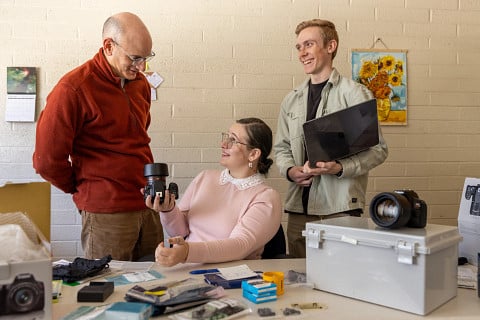The rapidly growing field of astroinformatics is spurring new scientific research all over the world, and NAU astronomers and informatics experts are helping to lead that growth. Professor David Trilling, chair of the Department of Astronomy and Planetary Science, was recently awarded a $452,885 grant from the National Science Foundation for a new project focusing on using advanced technologies to develop a rapid response capability that can track unusual asteroid behavior and broadcast real-time alerts.
Trilling and his team, including co-investigator Michael Gowanlock, assistant professor with NAU’s School of Informatics, Computing, and Cyber Systems, launched the three-year project to prepare for a much larger international effort focusing on the Legacy Survey of Space and Time (LSST). The survey will be hosted by the Vera C. Rubin Observatory from a mountaintop in north-central Chile beginning in 2024.
The LSST represents a more comprehensive survey of the sky than has ever been possible, as the 8.4-meter telescope—and the world’s largest digital camera—continuously images the entire sky. Over the course of the 10-year survey, the telescope also will record the time evolution of these sources, enabling scientists to view the first ‘motion picture’ of the Universe.
Public access is a key aspect of the LSST project, including its billions of images and petabytes of data,
which could yield answers to thousands of science questions. The LSST will give scientists all over the world the capability to address some of the most pressing questions about the structure and evolution of the Universe, such as the phenomena of dark energy and dark matter, as well as big problems such as where water exists in the solar system—and why.
“The LSST represents a total revolution in how we observe the sky,” Trilling said. “Astronomers will be able to take advantage of new technologies that provide an entirely new capability for our field.”
Team developing rapid response capability for rare and unusual asteroids
Trilling’s team is working with data from a smaller-scale precursor of the LSST—the Zwicky Transient Facility (ZTF) survey—to prepare for the LSST. Hosted by the Palomar Observatory in southern California, the ZTF scans the entire northern sky every two days. It is about one-tenth the size of the LSST.
“We’re looking at the ZTF data streams to identify unusual asteroids. These outliers will enable us to refine our understanding of the formation and evolution of asteroids and the Solar System by using these rare events as important physical constraints,” Trilling said. “Our team is developing a tightly integrated system that ingests alerts and produces interesting science. This new capability will maximize the asteroid science yield from both the ZTF and LSST, including rapid processing of observations of ‘outlier objects’ where unusual and time-critical behaviors require immediate confirmation. Developing this rapid response capability will be critical for both surveys. Ultimately, our biggest technical goal is to make sure we’re ready when the LSST starts to deliver data.”
SNAPS technology key to solving science problems
The project’s success will largely depend on advanced astroinformatics tools and capabilities as well as NAU’s Monsoon high-performance computing cluster (with a peak CPU performance of 224 teraflops) to process the enormous amount of data expected to be delivered by the LSST. Trilling and Gowanlock have been working to develop the Solar System Notification Alert Processing System (SNAPS), software that can process data from the billions of six-color images generated by the Rubin Observatory’s 3200-megapixel camera—which will be so large that 1,500 high-definition TV screens would be required to view each one.
Graduate student Maria Chernyavskaya, who is pursuing her Ph.D. in astronomy and planetary science, is focusing on the data, creating the real-time outlier detection algorithms, co-leading the follow-up efforts and carrying out science investigations of the active asteroids.
Project will educate Flagstaff students using PANOPTES robotic telescopes
Advancing science goes hand in hand with educating scientists of the future and engaging the public. Trilling and Gowanlock have hosted two astroinformatics bootcamps introducing students from diverse backgrounds to the data science behind astronomy, including writing and testing algorithms to measure the properties of asteroids. Now they’re building small robotic telescopes that will enable students at NAU, Flagstaff High School and Camp Colton to observe asteroids and learn about modern astronomy. The PANOPTES (Panoptic Astronomical Networked Observatories for a Public Transiting Exoplanets Survey) units are part of a citizen science project designed to make it easy and cost-effective to build using commercial off-the-shelf parts.
The telescopes will be about the size of microwave ovens, and the team will use them to explain concepts such as computer algorithms, data science and the LSST to the public. There will be three observing stations: NAU’s campus observatory; Flagstaff High School, where students can participate in the construction of a high-end amateur robotic telescope; and Camp Colton on Hart Prairie, an outdoor experiential camp for sixth-graders.
Chernyavskaya is co-leading the public engagement aspects of this project with Trilling by managing construction of the PANOPTES units, which use commercial off-the-shelf parts. She and Gavin Moriarty, physics and astrophysics major and president of the Astronomy Club, are building the telescopes.
“Most of my research consists of writing code and analyzing data, so building the telescope is a nice break,” Chernyavskaya said. “Putting the hardware together with my own hands allows me to think critically about how the type of data I work with comes to be in the first place. It’s a good way to link the pieces of the scientific process together.”
Moriarty’s passion is designing and building astronomy equipment, so working on this project is right up his alley. “I’m working on a project as practice for my career, getting school credit for it, and having the opportunity to talk with people building instrumentation at one of the biggest observatories on the continent! It’s giving me valuable experience.”
Kerry Bennett | Northern Arizona University




